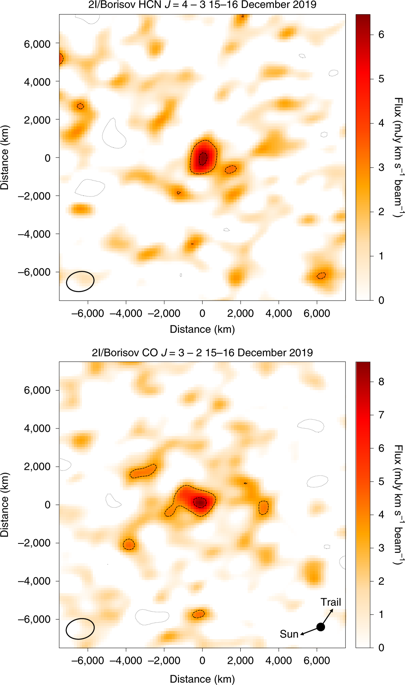Nature Astronomy ( IF 14.1 ) Pub Date : 2020-04-20 , DOI: 10.1038/s41550-020-1087-2 M. A. Cordiner , S. N. Milam , N. Biver , D. Bockelée-Morvan , N. X. Roth , E. A. Bergin , E. Jehin , A. J. Remijan , S. B. Charnley , M. J. Mumma , J. Boissier , J. Crovisier , L. Paganini , Y.-J. Kuan , D. C. Lis

|
Comets spend most of their lives at large distances from any star, during which time their interior compositions remain relatively unaltered. Cometary observations can therefore provide direct insight into the chemistry that occurred during their birth at the time of planet formation1. To date, there have been no confirmed observations of parent volatiles (gases released directly from the nucleus) of a comet from any planetary system other than our own. Here, we present high-resolution interferometric observations of 2I/Borisov, the first confirmed interstellar comet, obtained using the Atacama Large Millimeter/submillimeter Array (ALMA) on 15–16 December 2019. Our observations reveal emission from hydrogen cyanide (HCN) and carbon monoxide (CO) coincident with the expected position of 2I/Borisov’s nucleus, with production rates Q(HCN) = (7.0 ± 1.1) × 1023 s−1 and Q(CO) = (4.4 ± 0.7) × 1026 s−1. While the HCN abundance relative to water (0.06–0.16%) appears similar to that of typical, previously observed comets in our Solar System, the abundance of CO (35–105%) is among the highest observed in any comet within 2 au of the Sun. This shows that 2I/Borisov must have formed in a relatively CO-rich environment—probably beyond the CO ice-line in the very cold, outer regions of a distant protoplanetary accretion disk, as part of a population of small icy bodies analogous to our Solar System’s own proto-Kuiper belt.
中文翻译:

第一颗活跃的星际彗星异常高的CO丰度
彗星的一生大部分时间都与任何恒星相距很远,在此期间,它们的内部组成保持相对不变。因此,彗星观测可以直接洞察行星诞生时其诞生过程中发生的化学过程1。迄今为止,除我们自己的行星系统外,还没有观察到彗星的母体挥发物(直接从核释放出的气体)的确证观测。在这里,我们展示了2019年12月15日至16日使用阿塔卡马大型毫米/亚毫米阵列(ALMA)获得的第一个确认的星际彗星2I /鲍里索夫的高分辨率干涉观测结果。一氧化碳(CO)与2I /鲍里索夫核的预期位置重合,生产率Q(HCN)=(7.0±1.1)×10 23 s -1和Q(CO)=(4.4±0.7)×10 26 s -1。尽管HCN相对于水的丰度(0.06-0.16%)与我们太阳系中以前观察到的典型彗星的丰度相似,但CO的丰度(35–105%)是在2 au内任何彗星中观测到的最高值太阳。这表明2I /鲍里索夫一定是在相对富含CO的环境中形成的,可能是在遥远的原行星积盘的非常寒冷的外部区域中,超出了CO冰线的区域,这是类似于我们的小型冰冷体的一部分。太阳系自己的原始柯伊伯带。


























 京公网安备 11010802027423号
京公网安备 11010802027423号